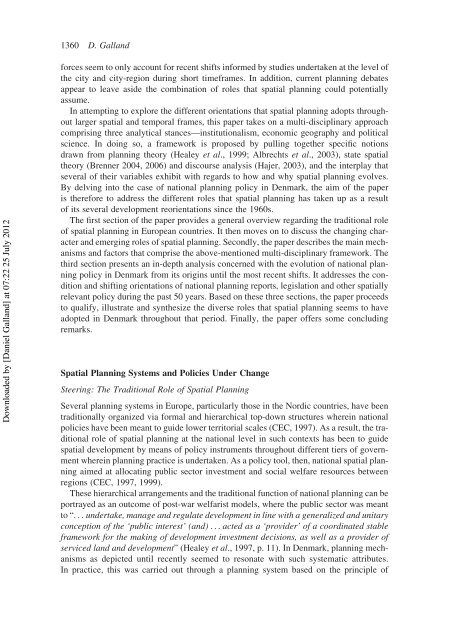Galland EPS 2012 - VBN
Galland EPS 2012 - VBN
Galland EPS 2012 - VBN
Create successful ePaper yourself
Turn your PDF publications into a flip-book with our unique Google optimized e-Paper software.
1360 D. <strong>Galland</strong><br />
Downloaded by [Daniel <strong>Galland</strong>] at 07:22 25 July <strong>2012</strong><br />
forces seem to only account for recent shifts informed by studies undertaken at the level of<br />
the city and city-region during short timeframes. In addition, current planning debates<br />
appear to leave aside the combination of roles that spatial planning could potentially<br />
assume.<br />
In attempting to explore the different orientations that spatial planning adopts throughout<br />
larger spatial and temporal frames, this paper takes on a multi-disciplinary approach<br />
comprising three analytical stances—institutionalism, economic geography and political<br />
science. In doing so, a framework is proposed by pulling together specific notions<br />
drawn from planning theory (Healey et al., 1999; Albrechts et al., 2003), state spatial<br />
theory (Brenner 2004, 2006) and discourse analysis (Hajer, 2003), and the interplay that<br />
several of their variables exhibit with regards to how and why spatial planning evolves.<br />
By delving into the case of national planning policy in Denmark, the aim of the paper<br />
is therefore to address the different roles that spatial planning has taken up as a result<br />
of its several development reorientations since the 1960s.<br />
The first section of the paper provides a general overview regarding the traditional role<br />
of spatial planning in European countries. It then moves on to discuss the changing character<br />
and emerging roles of spatial planning. Secondly, the paper describes the main mechanisms<br />
and factors that comprise the above-mentioned multi-disciplinary framework. The<br />
third section presents an in-depth analysis concerned with the evolution of national planning<br />
policy in Denmark from its origins until the most recent shifts. It addresses the condition<br />
and shifting orientations of national planning reports, legislation and other spatially<br />
relevant policy during the past 50 years. Based on these three sections, the paper proceeds<br />
to qualify, illustrate and synthesize the diverse roles that spatial planning seems to have<br />
adopted in Denmark throughout that period. Finally, the paper offers some concluding<br />
remarks.<br />
Spatial Planning Systems and Policies Under Change<br />
Steering: The Traditional Role of Spatial Planning<br />
Several planning systems in Europe, particularly those in the Nordic countries, have been<br />
traditionally organized via formal and hierarchical top-down structures wherein national<br />
policies have been meant to guide lower territorial scales (CEC, 1997). As a result, the traditional<br />
role of spatial planning at the national level in such contexts has been to guide<br />
spatial development by means of policy instruments throughout different tiers of government<br />
wherein planning practice is undertaken. As a policy tool, then, national spatial planning<br />
aimed at allocating public sector investment and social welfare resources between<br />
regions (CEC, 1997, 1999).<br />
These hierarchical arrangements and the traditional function of national planning can be<br />
portrayed as an outcome of post-war welfarist models, where the public sector was meant<br />
to “...undertake, manage and regulate development in line with a generalized and unitary<br />
conception of the ‘public interest’ (and) ...acted as a ‘provider’ of a coordinated stable<br />
framework for the making of development investment decisions, as well as a provider of<br />
serviced land and development” (Healey et al., 1997, p. 11). In Denmark, planning mechanisms<br />
as depicted until recently seemed to resonate with such systematic attributes.<br />
In practice, this was carried out through a planning system based on the principle of
















